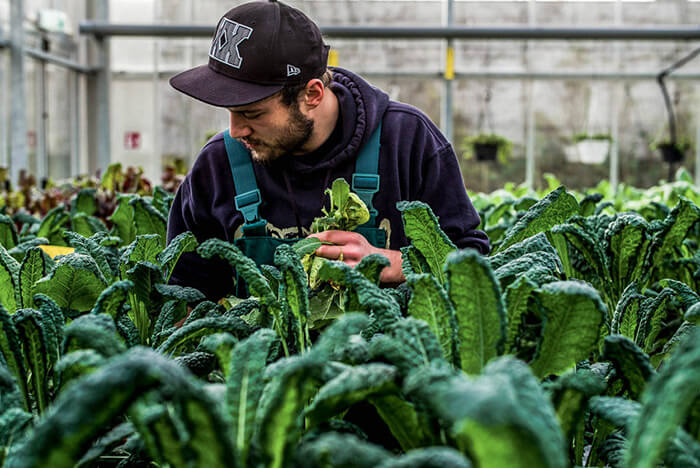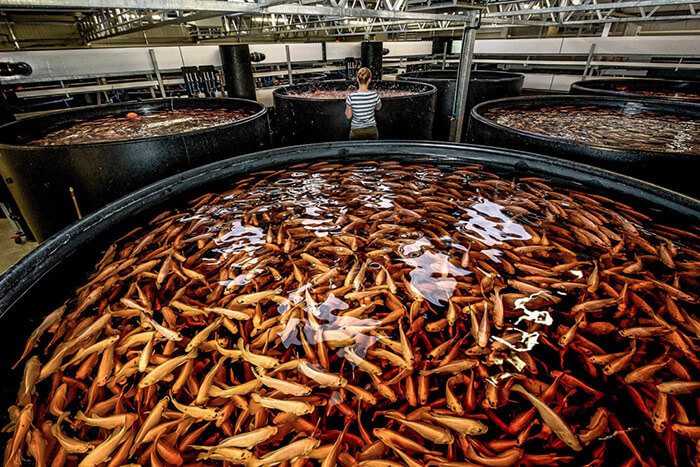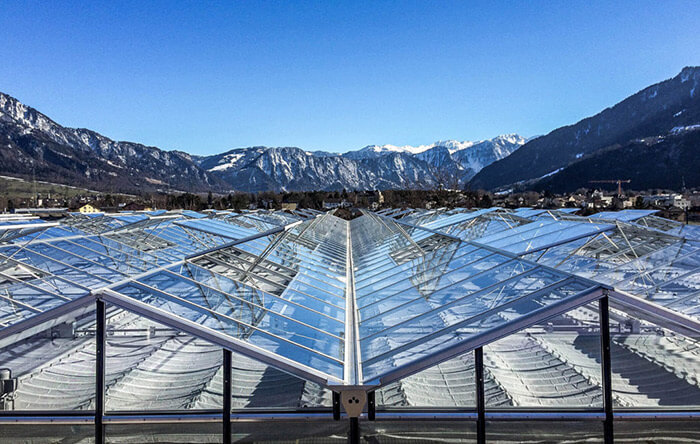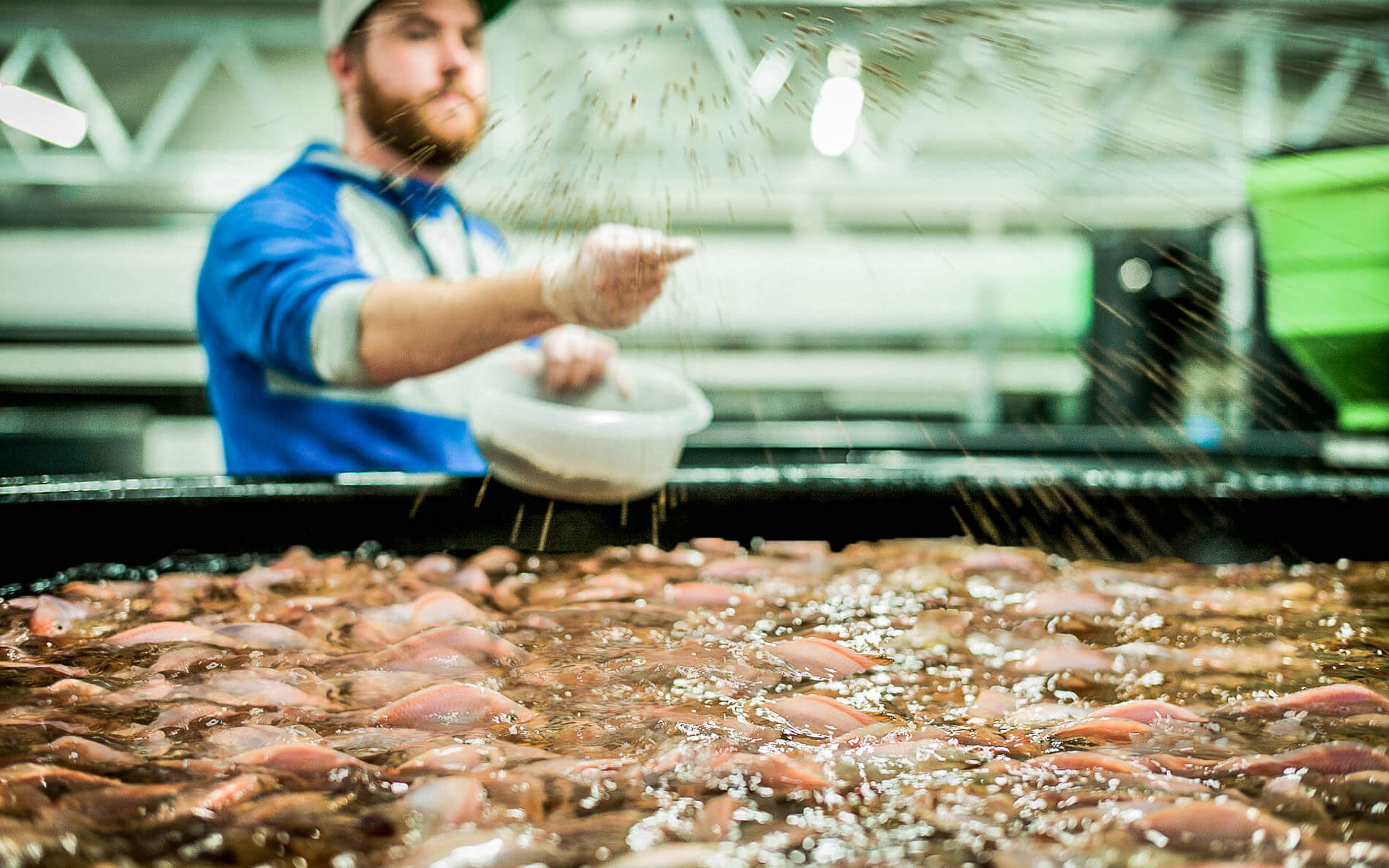Tonight’s stars, arranged into meticulously crafted courses, include catfish cooked in ashes Peruvian style, eel in Brazilian moqueca, and sturgeon with truffles—fish makes regular appearances at this Michelin-starred gourmet temple. But the fresh-caught delicacies on these decorative plates aren’t just unusually delicious, they’re also deliciously unusual: the sea is a stone’s throw away, but not one of these fish has ever set a fin in it.
Sieh dir diesen Beitrag auf Instagram an
Aquaponics – making a splash
Sollo, not far from Malaga, is the only restaurant of its kind in the world, and represents a kind of mini-food revolution. Nearly all of the vegetables and freshwater fish it serves are grown, or raised, in-house; and there is the big target: to cut the “nearly” out of that sentence .

Image: ECF Farmsystems GmbH
It’s all possible with the help of a greenhouse with its own aquaponic system: for nearly two years now, Gallego has been demonstrating that fish and salad make a great team even outside the kitchen. It’s a new trend to us, but even the ancient Mayans were well aware of this symbiotic relationship between trout and tomatoes, sturgeon and spinach. Aquaponics means combining aquaculture (raising aquatic plants and animals) with hydroponics (growing vegetables without soil) into a single closed system where culinary delights and sustainability go hand in hand.
Sieh dir diesen Beitrag auf Instagram an
The actual technology is somewhat less romantic—tomato plants hanging from the ceiling, where catfish are blubbing around in a tank—but it’s certainly efficient.
The fish excrete waste that contains highly poisonous ammonia, which special bacteria convert into nitrates… which is a key component of fertilizer. This nutrient-rich cocktail flows into a second tank and into the roots of the flourishing plants. They, in turn, filter the water through absorption, making it safe to pump back to the fish. It’s a continuous circle of life that benefits both of them: the plants grow faster, require less space, and use less water while the fish require just seven cubic meters of water per kilo—a far cry from the 100 cubic meters required to raise fish by conventional means.
In fact, the only water lost is through evaporation, harvesting and cleaning the filter machines. In short, these tanks may contain nothing less than the future of fisheries.
Bridging troubled waters sustainably

Image: ECF Farmsystems GmbH
Overfished oceans, filthy aquafarms, wastewater overflowing with medications… today’s fisheries aren’t exactly known as beacons of environmental consciousness. If you need proof that the food industry is in desperate need of new solutions, just take a look at a world population graph: we’ve currently got 7.5 billion mouths to feed, and in 30 years it will be close to 9.8 billion. Meanwhile, less and less of the Earth’s land is suitable for agriculture. It’s a gigantic problem, but one that aquaponics could help solve, both by providing more food security and by solving some of the problems associated with the seafood industry, which is growing faster than any other livestock sector.
Aquaponics has the added ecological benefit of being practically emissions-free, and is also totally unaffected by natural variables like drought, flooding, sunlight, or temperature— the factors that create unforeseen harvest or breeding difficulties for traditional hatcheries and agricultural operations are non-issues for aquaponic systems.
Aquaponics are perfect for any vegetable apart from root veggies like carrots and potatoes, and the systems can be operated all year round; the fish, however, can only be freshwater varieties. Another small obstacle is that these fish-plant partnerships aren’t eligible for “organic” labeling in the EU, at least not yet: EU regulations specify that organic vegetables have to be grown in soil. Fortunately, in the US, the global leaders in aquaponics are not only profitable, they’re certified as organic.
Fish was never fresher
Fresh tilapia, served in fillet form just hours after it was caught, is something you’d normally associate with a beach vacation rather than an old converted factory. But smack in the middle of Berlin’s Schöneberg neighborhood, ECF Farmsystems is selling “capital city perch” raised sustainably, free of antibiotics and GMOs. There are around 20 tons of fish here, swimming around alongside basil before eventually making their way to selected supermarkets and restaurants: ultra-local perch smoked or pan-fried to perfection—impressive from both a culinary and an environmental standpoint.
ECF is in good company in Berlin, in fact. In the southeastern part of the city, on Lake Müggelsee, researchers with the Leibnitz Institute of Freshwater Ecology and Inland Fisheries are hard at work on their aquaponic “tomato fish”. Experts hailing from Germany, Spain, Belgium, and China are now conducting large-scale experiments involving the method.
With the arrival of the start-up Blün in October 2016, Austria now has its own aquaponic system, too. The mayor of Paris has expressed interest in starting a farm using the ECF model, and on Lake Ohrid between Albania and Macedonia, locals are clamoring for an aquaponic farm to help protect a threatened species of trout. It won’t be long before the fish with the plant flatmates are making waves all across the world.
Gastronomic potential from American eel to zander

Image: ECF Farmsystems GmbH
Aquaponic fish works for the restaurant industry because it’s in the spirit of the times. People want fish that’s fresh-caught and local, without the long transport distances and cold storage times that hurt both flavor and the environment. In reality, of course, the current situation couldn’t be more different: around a third of the fish we eat comes from fisheries, which are responding to ever-growing demand with overcrowded pools containing more antibiotics than healthy fish. Nowadays, even consumers are starting to doubt the fairy tales of ultra-fresh fish that was tumbling around in the brook just this morning. Meeting the demand for regional, sustainable products is becoming a challenge, especially as globalization increases and resources become more scarce.
Sieh dir diesen Beitrag auf Instagram an
Aquaponic systems for fish and vegetables are a resource-efficient way of meeting the problem head-on. Moreover, high-quality products are increasingly seen as a unique selling point, and are part of the storytelling that is becoming so important within the restaurant industry. One look at the growing spectrum of sustainable products will tell you that the industrial and retail sectors are starting to take notice of this trend, too. Overfishing, climate change, and fish marinated in antibiotics are hard to swallow, but consumers aren’t quite ready to give up their tuna salad sandwiches just yet. The hipster capital of the world may offer a shimmer of hope in that regard with its capital city bass. Just don’t forget to order the salad to go with it… they were practically made for each other.
Further trends you need to know:
How insects are revolutionizing gastronomy
Will 3D food printers revolutionize the restaurant industry?
















